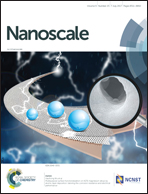Visualization of the protein corona: towards a biomolecular understanding of nanoparticle-cell-interactions†
Abstract
The use of nanocarriers in biology and medicine is complicated by the current need to understand how nanoparticles interact in complex biological surroundings. When nanocarriers come into contact with serum, proteins immediately adsorb onto their surface, forming a protein corona which defines their biological identity. Although the composition of the protein corona has been widely determined by proteomics, its morphology still remains unclear. In this study we show for the first time the morphology of the protein corona using transmission electron microscopy. We are able to demonstrate that the protein corona is not, as commonly supposed, a dense, layered shell coating the nanoparticle, but an undefined, loose network of proteins. Additionally, we are now able to visualize and discriminate between the soft and hard corona using centrifugation-based separation techniques together with proteomic characterization. The protein composition of the ∼15 nm hard corona strongly depends on the surface chemistry of the respective nanomaterial, thus further affecting cellular uptake and intracellular trafficking. Large diameter protein corona resulting from pre-incubation with soft corona or Apo-A1 inhibits cellular uptake, confirming the stealth-effect mechanism. In summary, the knowledge on protein corona formation, composition and morphology is essential to design therapeutic effective nanoparticle systems.



 Please wait while we load your content...
Please wait while we load your content...